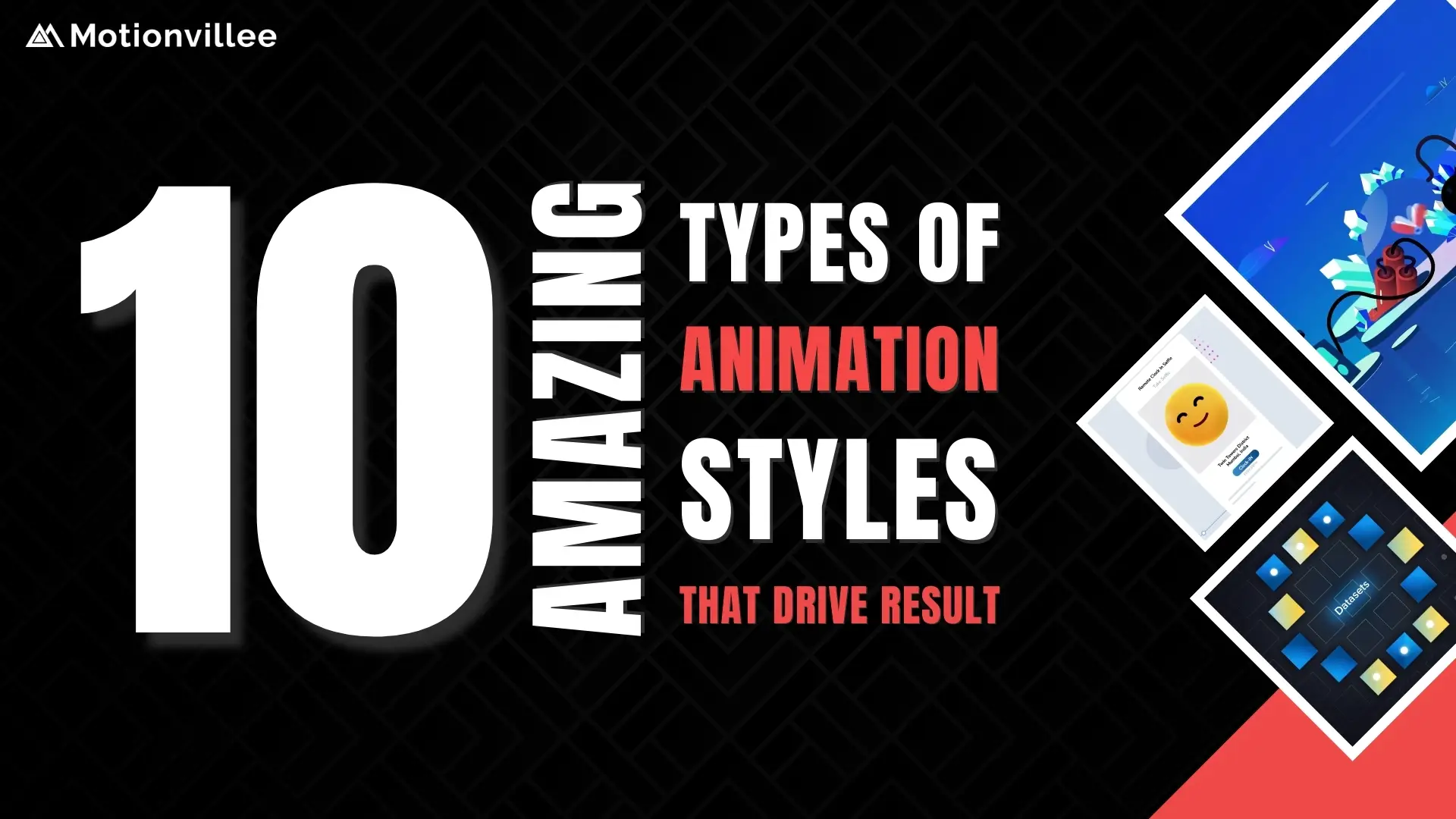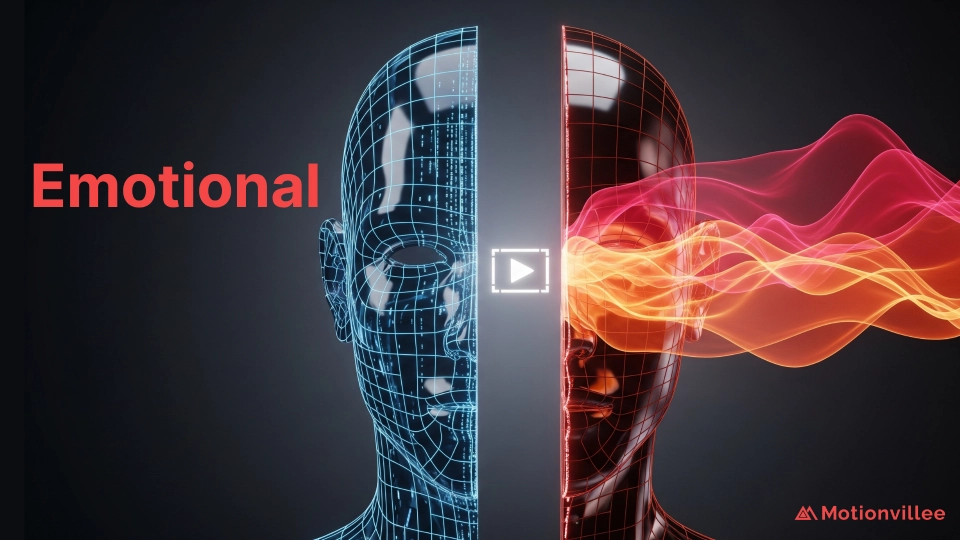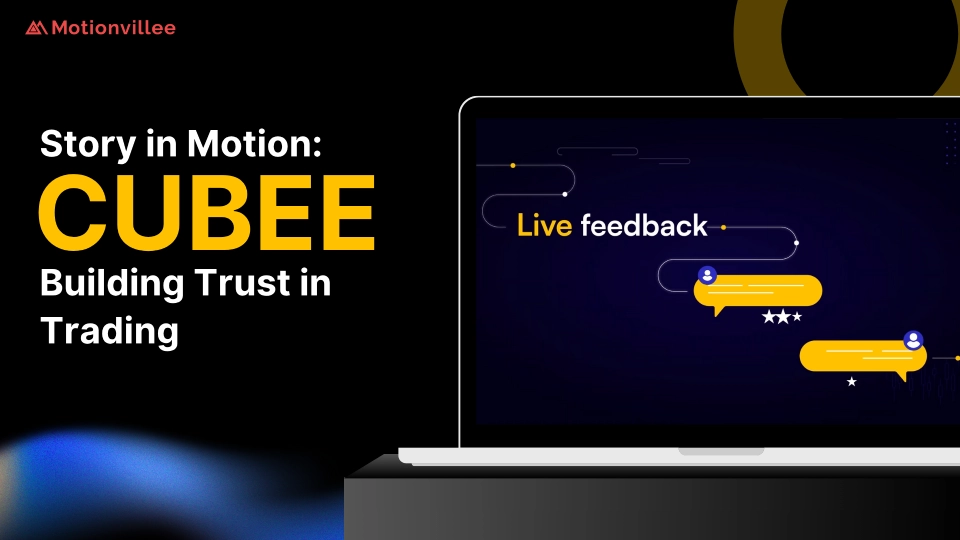Choosing the right animation style for your brand can feel difficult with so many creative options on the table. At Motionvillee, we get it. Having partnered with leading brands, we’ve seen firsthand how the right animation can transform a brand’s message into a compelling story.
But let’s be honest—figuring out which animation style aligns with your goals can be tricky. How do you ensure it drives the results you need while keeping your audience hooked?
In this article, we’ll break down 10 powerful types of animation, complete with examples to show you how they can elevate your next campaign. Whether you’re aiming to educate, entertain, or inspire, we’re here to guide you toward the style that will bring your vision to life.
Ready to find the perfect fit for your brand? Let’s dive in!
1. Stop Motion Animation
Stop motion animation is a meticulous process of capturing individual frames of physical objects, with incremental movements between frames. When these frames are played in sequence, they create the illusion of motion. This technique is cherished for its tangible and handcrafted feel, which sets it apart from other animation styles.
Key Techniques:
- Models or puppets are positioned on a set and manually adjusted.
- Frames are captured using specialized cameras or software.
- Lighting and shadows are controlled to maintain consistency.
Applications:
- Entertainment: Iconic films like Coraline and Fantastic Mr. Fox demonstrate how stop motion can bring intricate stories to life with a unique visual texture.
- Advertising: Brands often use stop motion for its playful and engaging aesthetic. Quirky commercials or product demonstrations frequently rely on this technique to stand out.
Why It Works:
Stop motion’s artisanal quality appeals to audiences who value craftsmanship. The tactile charm of real-world objects brought to life creates an emotional connection, making it an enduring favorite.
How It Works:
Stop-motion animation offers a unique and captivating way to showcase products, helping businesses differentiate themselves in competitive markets.
This technique is especially powerful for highlighting product features, telling brand stories, and crafting unforgettable advertisements that engage audiences and boost brand visibility.
2. Claymation
A subset of stop motion animation, claymation involves the use of malleable clay models as primary characters and props. Clay’s versatility allows animators to create smooth transitions and expressive movements.
Key Techniques:
- Sculpting characters and sets from clay.
- Frame-by-frame manipulation of shapes to depict movement.
- Blending colors and textures for creative effects.
Applications:
- Kids’ Content: Shows like Shaun the Sheep captivate young audiences with their charmingly whimsical narratives.
- Feature Films: Franchises like Wallace and Gromit exemplify how claymation can achieve global acclaim through imaginative storytelling.
Why It Works:
Claymation’s ability to morph shapes and create surreal effects opens up endless creative possibilities. Its hands-on aesthetic and vibrant visuals make it especially engaging for audiences of all ages.
How It Works:
Claymation brings warmth and character to brand storytelling, making it both relatable and unforgettable for audiences.
By incorporating claymation, brands can humanize their image, craft engaging stories, and build emotional bonds with customers, ultimately boosting brand loyalty and engagement.
3. Rotoscope Animation
Rotoscoping is a hybrid animation technique that traces live-action footage to create animations with a blend of realism and abstraction. Animators draw over each frame of real-world movements, ensuring lifelike fluidity.
Key Techniques:
- Live-action scenes are shot as a base layer.
- Frames are traced manually or digitally to animate characters.
- Stylization adds an artistic flair to otherwise realistic motions.
Applications:
- Music Videos: The iconic video for Take On Me by A-ha blends live action and animation for a memorable visual effect.
- Movies: Films like Waking Life utilize rotoscoping to evoke a dreamlike, introspective quality.
Why It Works:
Rotoscoping bridges realism with creative artistry, providing a unique storytelling medium. Its mix of real-world familiarity and imaginative enhancements captivates viewers and creates a lasting impression.
How It Works:
Rotoscope animation combines realism with artistic flair, making it an effective tool for explaining complex concepts and processes. Both large and small businesses can leverage rotoscoping to simplify information, boost comprehension, and create visually engaging content that connects with audiences, ultimately enhancing brand credibility and authority.
4. 2D Animation / Traditional Animation
The earliest form of animation, 2D animation involves creating flat, two-dimensional visuals drawn frame by frame. It requires exceptional artistry and precision, as each movement is meticulously crafted.
Key Techniques:
- Characters and backgrounds are hand-drawn or digitally illustrated.
- Movements are sequenced frame by frame to depict fluid motion.
- Layers of animation are integrated for depth.
Applications:
- Classic Films: Disney’s The Little Mermaid and Aladdin showcase the timeless appeal of 2D animation in storytelling.
- Explainer Videos: Businesses use 2D animations to simplify complex concepts and engage audiences.
Why It Works:
The nostalgic charm of traditional 2D animation evokes an emotional response. Its simplicity, versatility, and cost-effectiveness make it ideal for various applications, from entertainment to marketing.
How It Works:
2D animation is highly versatile and adaptable, making it an ideal choice for a wide range of marketing goals and target audiences.
You can use 2D animation to craft explainer videos, social media content, and training materials that clearly convey important messages, boost engagement, and strengthen brand identity. This approach can help drive customer conversions and foster long-term loyalty.
5. 3D Animation
3D animation leverages computer-generated imagery (CGI) to create visuals with depth, perspective, and realism. This technique has revolutionized industries like film, gaming, and advertising.
Key Techniques:
- 3D modeling of characters and environments.
- Rigging and animating skeletal frameworks for movement.
- Rendering realistic textures, lighting, and effects.
Applications:
- Movies: Blockbusters like Frozen and Toy Story set benchmarks for visual storytelling in 3D animation.
- Gaming: Modern video games heavily rely on 3D modeling and animation to create interactive and immersive worlds.
Why It Works:
3D animation’s ability to mimic reality while enhancing it with fantastical elements makes it highly engaging. Its lifelike details captivate audiences and deliver an immersive visual experience.
How it Work
3D animation provides an immersive experience that effectively highlights products or services in great detail.
Businesses can leverage 3D animation in product showcases, advertisements, and virtual experiences to engage audiences, boost brand visibility, and drive growth in sales and revenue.
6. Motion Graphics
Motion graphics combine animated text, shapes, and visual elements to communicate messages clearly and concisely. Unlike character-based animation, it focuses on abstract visuals.
Key Techniques:
- Dynamic transitions, typography, and graphical elements.
- Integration of sound design for added impact.
- Software like After Effects is often used for creation.
Applications:
- Marketing: Eye-catching social media campaigns and video ads often rely on motion graphics for instant engagement.
- Corporate Videos: Motion graphics simplify complex data, making it accessible for business presentations.
Why It Works:
Motion graphics excel at grabbing attention quickly, making them perfect for digital platforms. Their clarity and adaptability ensure they effectively convey messages to diverse audiences.
How it Work
Motion graphics animations elevate brand communication and storytelling by transforming complex information into engaging and easily digestible content for audiences.
Businesses can leverage sleek motion graphics in advertisements, presentations, and branding materials to capture attention, deliver messages clearly, and create a lasting impact. This leads to stronger brand recognition and improved recall among customers.
7. Typography Animation
Typography animation brings static text to life through movement, emphasizing the content’s message in a visually appealing way.
Key Techniques:
- Animating text to create rhythm and flow.
- Combining kinetic typography with graphic design elements.
- Synchronizing motion with music or voiceovers.
Applications:
- Social Media: Platforms like Instagram and TikTok feature typography animations in stories and ads to drive engagement.
- Promotional Content: Typography animations emphasize brand messages in dynamic, eye-catching ways.
Why It Works:
Typography animation enhances readability while retaining viewer interest. It is ideal for delivering concise yet impactful messages.
How it Work:
Typography animation infuses brand messaging with visual appeal and emotion, making it more compelling and memorable for audiences.
It can be used in title sequences, TV commercials, and promotional videos to capture attention, evoke emotions, and strengthen brand identity, ultimately boosting customer engagement and loyalty.
8. Animation with Live Action
This hybrid style merges animated elements with live-action footage, creating an engaging interplay between real-world and imagined visuals.
Key Techniques:
- Combining filmed footage with 2D or 3D animations.
- Seamless integration of elements to ensure coherence.
- Use of green screens or compositing software.
Applications:
- Movies: Who Framed Roger Rabbit remains a classic example of this innovative technique.
- Advertising: Brands add whimsy to real-world settings using animated overlays.
Why It Works:
This technique enhances storytelling by blending the familiar with the fantastical. It allows for limitless creative expression while grounding it in reality.
How it Work:
Animation combined with live action blends the best of both worlds, crafting immersive and unforgettable experiences for audiences.
This technique can be applied in commercials, training videos, and interactive marketing campaigns to tell compelling stories, elevate brand perception, and inspire customer action, ultimately boosting brand affinity and conversion rates.
9. Whiteboard Animation
Whiteboard animation simulates hand-drawn visuals on a whiteboard, making it a popular choice for educational and explanatory content.
Key Techniques:
- Digital or manual drawing of illustrations.
- Step-by-step visual representation of ideas.
- Voiceovers often accompany the visuals for clarity.
Applications:
- Education: Used in e-learning modules to simplify topics.
- Corporate Training: Whiteboard animations help convey complex business strategies.
Why It Works:
Its simplicity and straightforward approach make it easy for viewers to grasp concepts. Whiteboard animation’s casual style fosters a sense of approachability and relatability.
How it Work
Whiteboard animation breaks down complex concepts, making them clear and engaging for audiences.
Businesses can use whiteboard animation in educational videos, explainer videos, and presentations to showcase expertise, build trust, and position themselves as thought leaders in their industry, ultimately fostering customer engagement and loyalty.
10. Frame-by-Frame Animation
This technique involves creating each frame individually, offering unparalleled control over the final result.
Key Techniques:
- Drawing every movement from scratch.
- High attention to detail ensures precision.
- Often used in traditional or experimental projects.
Applications:
- Artistic Projects: Indie films and avant-garde animations often rely on this labor-intensive technique.
- Classic Animation: Early Disney works, such as Snow White, showcase the beauty of frame-by-frame craftsmanship.
Why It Works:
Frame-by-frame animation offers unmatched detail and fluidity. Its precision makes it the gold standard for high-quality productions.
How it Work:
Frame-by-frame animation provides meticulous control over movement and expression, making it perfect for creating engaging narratives and character animations.
Companies can utilize frame-by-frame animation in ads, storytelling videos, and brand mascots to craft memorable experiences that connect with audiences, enhancing brand affinity and boosting customer loyalty.
Conclusion
Animation, once a niche art form, has evolved into a powerful medium that shapes our culture, educates, and entertains. Its versatility is undeniable, capable of bringing to life anything from fantastical creatures to complex scientific concepts.
In today’s digital age, animation plays a crucial role in various aspects of modern society. It’s used in advertising, education, entertainment, and even therapy. By engaging our visual senses, animation can convey messages more effectively than traditional text-based formats.
The future of animation is brimming with exciting possibilities. As technology continues to advance, we can expect to see even more innovative and immersive animation experiences. From virtual reality to artificial intelligence, the boundaries of animation are constantly being pushed.
As we look ahead, it’s clear that animation will remain a vital part of our world. Its ability to inspire, educate, and entertain will continue to captivate audiences of all ages.







